Since I returned from my hiatus in Africa I´ve taken to wearing a new hat I bought earlier this summer. It´s origin is from Ecuador, where authentic versions are manufactured, though the style itself was made famous by Theodore Roosevelt when he wore one in a strategic photo op for the Panama Canal construction in the early 1900´s -- hence the name, Panama hat. But what delights me most about my new favorite accessory is not the casual, breezy feeling I immediately assume whenever I don it, but rather the inevitable comments I receive from a very particular demographic of Andalusian men.
Allow me to be frank. I do happen to find Spanish men to be attractive. But what sets apart these men is that they are almost always of a certain age; I´m sure you know the type. Slicked back salt-and-pepper hair or most likely balding, they are the kind who walk with a deliberate stride clasping their hands behind their backs. They are almost always seen in groups of three or more -- never alone -- and are either hanging outside the local bar in the middle of the day (of which, Andalucia has many), cerveza and smoke in hand, or they are walking to the next local bar down the street.
Ordinarily I most certainly would find their boisterous, overt comments rather forward and borderline offensive, but when I´m wearing my new Panama hat, the comments turn somehow endearing. More about the hat as an object of admiration rather than the random cat-call from a complete stranger. ¡Qué arte!, or ¨What style!¨ they say as I walk the narrow streets of Cádiz. Yesterday one man caught me in mid-stride and bellowed, ¨El sombrero más guapo!¨ A most handsome-looking hat! Even the man behind me in the supermarket line mumbled something to me as I was paying for my groceries. In truth I have no idea what he said, but I distinctly heard the word sombrero, so I looked him in the eye, smiled and said, ¡Graciaaa! in my best Andaluz.
Ordinarily I most certainly would find their boisterous, overt comments rather forward and borderline offensive, but when I´m wearing my new Panama hat, the comments turn somehow endearing. More about the hat as an object of admiration rather than the random cat-call from a complete stranger. ¡Qué arte!, or ¨What style!¨ they say as I walk the narrow streets of Cádiz. Yesterday one man caught me in mid-stride and bellowed, ¨El sombrero más guapo!¨ A most handsome-looking hat! Even the man behind me in the supermarket line mumbled something to me as I was paying for my groceries. In truth I have no idea what he said, but I distinctly heard the word sombrero, so I looked him in the eye, smiled and said, ¡Graciaaa! in my best Andaluz.
Yes, I realize these men are generous with the compliments because they either have the exact same hat hanging on their hat rack back at home or have misplaced theirs at the last feria or Carnaval. More a nod to their own taste than an honest form of flattery. But a little recognition, when given on the right occassion such as wearing a smart hat, even if it is only in the spirit of comradery, is welcome and most definitely appreciated.













